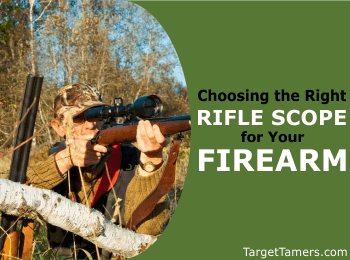
Will this scope handle my rifle's recoil?
Is a long range scope overkill for an AR-15?
Do I use a rifle scope on an air gun?
These are by far some of the most common questions that shooters and hunters want answers to. Just check any scope or shooting forum, Q&A, and manufacturer's product review section - they're loaded with similar concerns.
Instead of googling several websites just to find the one answer you need, don't go anywhere else. We've got all the answers you need in one place.
Keep reading for peace of mind in knowing you're getting the right rifle scope for your firearm.
How Do You Know...?
How do you know if a scope is going to hold up?
If it's recoil proof? If it'll range out far enough? If it'll get the job done?
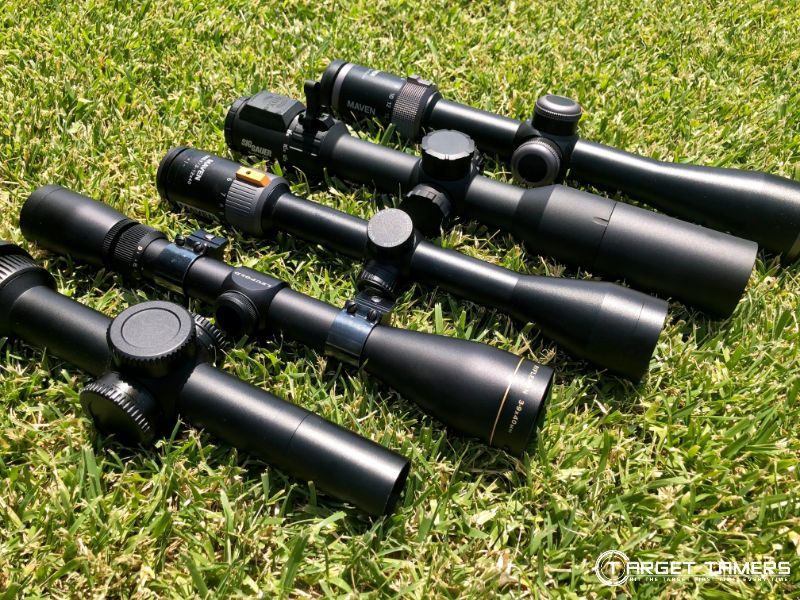
If you haven't been able to get your hands on the rifle scope you want to buy, you're forced to make all of your buying decisions according to several factors...
From other people's experiences and their use out of the scope to what the manufacturer tells you and their marketing tactics, you're at the mercy of the "for-and-against" crowd.
Get the Right Scope for Your Firearm
When buying a rifle scope seemed like it was going to be an easy process, it just got incredibly confusing. But, it doesn't have to be...
In this article, we will provide you with clear, practical, and informative advice to ensure you select the right rifle scope for your firearm.
The only problem is, there are literally thousands of firearms that you can mount an optic to!
Instead of addressing each firearm individually, we'll discuss what rifle scopes and features will be a good buy according to your shooting and hunting activities.
We'll also mention some specific rifles and loads to help you better relate to our advice so that you can make the most informed decision when you're ready to narrow down your options.
Long Range Hunting
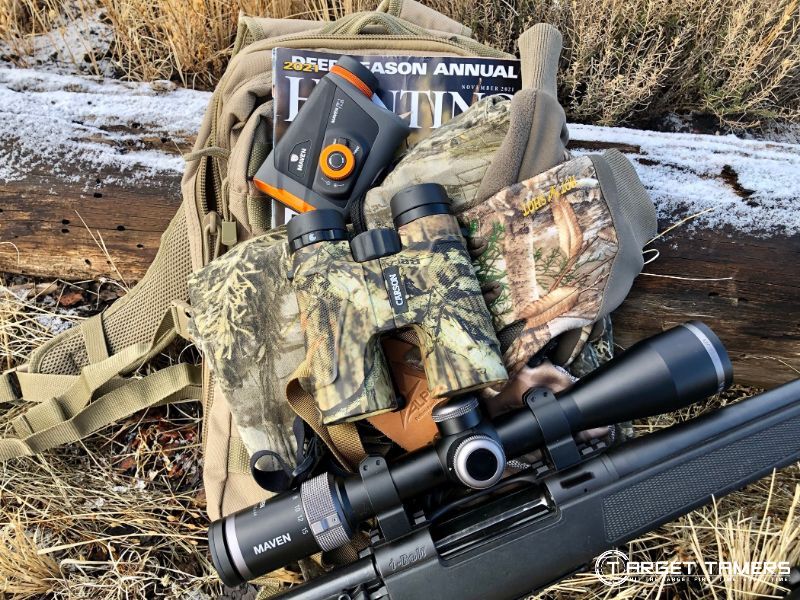
Whether you're taking down your prey from that far-away distance or you're testing your sniping skills in the 1000 yard plus range, there's a scope for you.
But before we even begin to consider which long range scope you need, here are few things to take into consideration about long range hunting.
Defining Long Range
"Long range" can mean different things for every shooter. For the sake of this article, it's going to need a little defining.
Arguably, anything beyond 500 yards is long range and to be on the conservative side, we'll consider distances beyond 300 yards long range. Distances beyond 1000 yards is what we're going to consider extreme long range.
Some people say long range starts at the point where wind drift, parallax, and atmospheric conditions start their roles, and while this is also true, long distance is also caliber specific.
Don't forget to take the velocity of your caliber and the performance of your firearm into consideration.
Know Your Kill Zones
Make sure that you know what it takes to bring down your target. When searching the market for long range rifle scopes, you should always be reminded about kill zones and vitals.
While it's popular in the shooting community to say that hunters don't need the same precision as target/competition shooters, you're still dealing with a live being where you need to know how to take it down with as minimal pain and suffering as possible.
Now is probably a good time to review the size of the vital zones for your targets.
Consider BC & Muzzle Velocity
There are two factors that affect long range capacity when it comes to caliber: Bullet Coefficient (BC) and muzzle velocity.
BC is the value of how easily the bullet moves through the air. Muzzle velocity is the speed the bullet leaves the muzzle and covers a distance in feet per second (fps).
For long range, the higher the BC is, the better the performance. BC ranges from 0.40 on the average end to over 0.70 on the highest end.
Common Long Range Calibers
Some common long range calibers and their approximate maximum deer range:
- .270 Win, .270 WSM - 600-710 yards
- .300 H&H Mag, .300 WSM, and .300 Win Mag. - 860 yards
- .30-06 - 680 yards
- .308 - 580 yards
- .338 Lapua - 900+ yards
- 7mm Win Mag, 7mm-08 - 600-780 yards
With your idea of "long range hunting" clearly defined, a firm knowledge of kill zones, BC and calibers, you are now ready to dive in and consider what you need in a long range hunting rifle scope.
Explore our comprehensive guide featuring the top-rated scopes perfectly suited for enhancing the performance of your 270 win rifles.
What to Look For in a Long Range Hunting Rifle Scope
1. Great Glass
Quality cannot be overstated if you're thinking about getting into the long range game.
The best way to test the glass is to get your eyes on the scope. If it's not possible to look through it with your own set of eyes first, play it safe and stick with a quality brand that pumps out exceptional glass.
They can be Leupold, Swarovski, Zeiss, Nightforce, and Vortex scopes - check out these for a start.
2. High Powered Optics
Not only is caliber important to get you out to those long range distances, the magnification range is also.
To hit 4-6 inch vital zones on your target out past 400 yards, you need excellent rangefinding equipment and optics. Look for rifle scopes that have high magnification. This could be in the 4-16X, 5-20X, 5.5-22, or the 6-24X range.
3. BDC Reticles or a Ballistic Turret
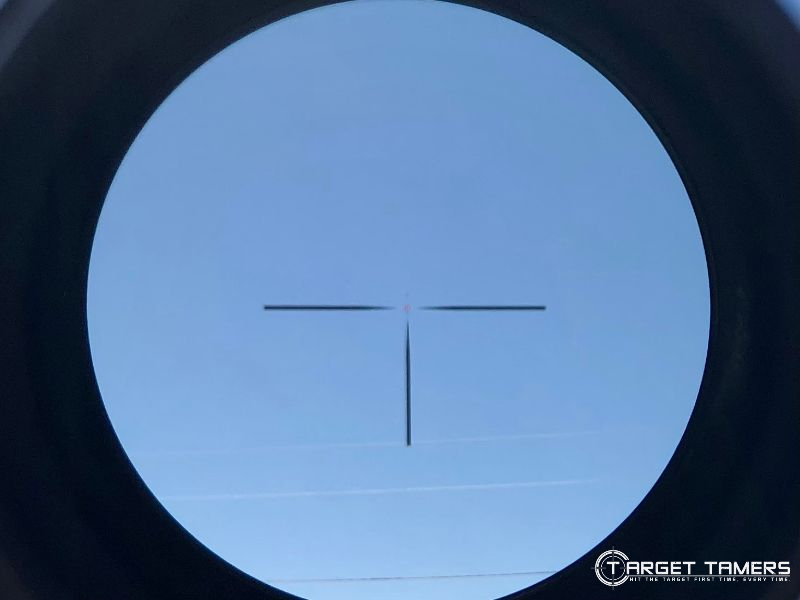
The further out you plan on shooting, the more important it is that you can cater for bullet drop and holdovers in your long distance shot.
Ballistic reticles can get really fancy. A simple BDC reticle may be all of you need for that 400 yard shot. You may want to consider a Christmas tree style reticle to get out to 800 yards. Perhaps a ballistic turret might intrigue you more if you're looking at distances past 1200 yards.
4. Internal Adjustment Range
This is specifically how much internal range the elevation turret can be adjusted for.
The more internal range capacity is available, the further out you can shoot - as long as your caliber can keep up.
You want to look for elevation MOA of more than 100, but definitely not less than 80.
You might also want to look for 30 mm tube scopes since they offer more internal range than a 1 inch scope.
5. Parallax Adjustment
Cranking up your magnification range to prep for the long range shot may just throw your image off the reticle focal plane.
Look for an adjustable objective or side focus turret to get back on center. Getting out further means nothing if you can't be sure you're not going to be dead on.
6. Illumination
Long range rifle scopes often have very fine cross hairs. This is to help improve accuracy and preciseness to ensure you can see vital zones on your far-away target.
If you didn't know, the illumination control isn't just for low light use, it can help you to see your cross hairs no matter how far away your target is.
7. Consider an FFP Rifle Scope
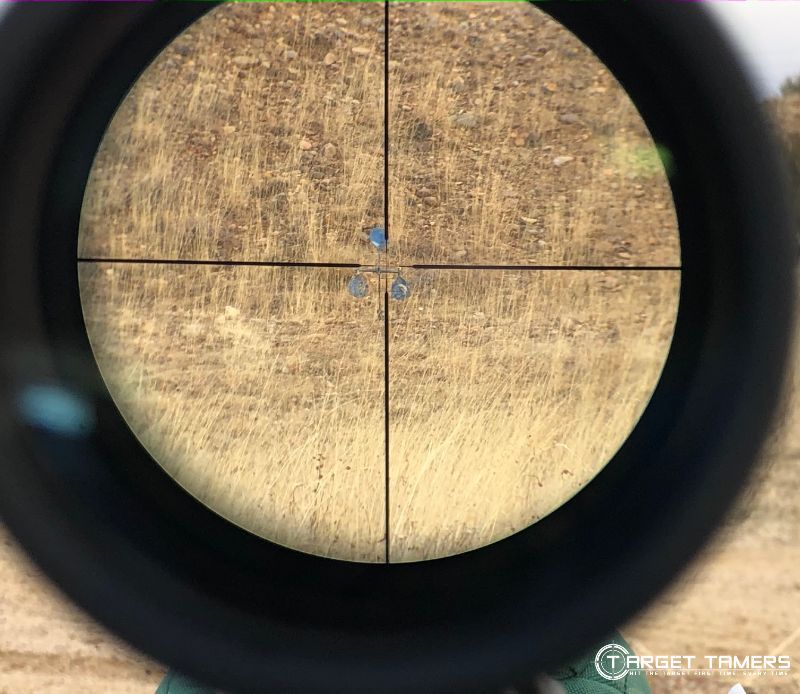
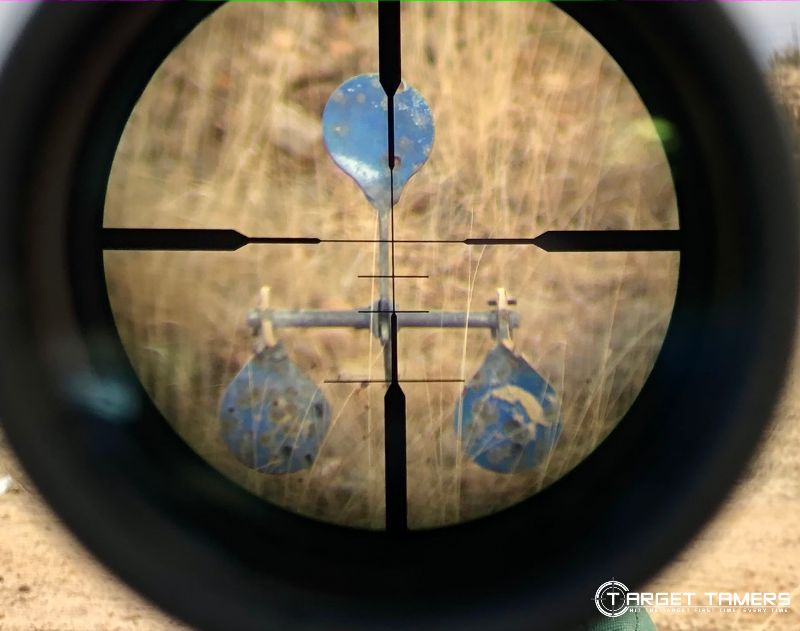
Considering a scope with a front focal plane reticle is an important decision to make when buying a long range hunting rifle scope.
You can use the ballistic reticle at any magnification with accurate measurement markings.
Although FFP reticles are difficult to see at low power, like 3-5X, it's really not an issue since the best first focal plane scopes are outfitted for those long range shots where low power magnification is hardly ever used.
Tip:
Just remember that you want quality glass and high-functioning features to make those well-placed, long distance shots.
With distances like these, there's no compromising on cost.
High power, BDC reticles, and illuminated scopes are going to give your wallet a beating. Just be prepared to dish out the cash if you plan on dishing up that deer at 700 yards.
Benefits of Long Range Scopes:
- Often has added bells and whistles
- Can shoot out to distances beyond 500 yards
- Combined with a low powered setting, is versatile for close range hunting
- Can be built with 30 mm tube body
- Can handle a lot of and repeated recoil abuse
- Often more sturdy, rugged, and robust in construction
Disadvantages of Long Range Scopes:
- The added features tack on more cost
- Overall, more costly than standard rifle scopes
- Can be on the heavy side weighing more than 16 ounces
Check Out Our Pick of the Best Long Range Scopes Here.
All-Round Hunting
You're just the typical hunter puttin' chow in the family's mouths and you're not lookin' for anything fancy and shmancy.
If you're wanting to put down deer, elk, and whatever else will end up on the table within the sub-250 yard range, then you're the kinda hunter I'm talkin' to.

What to Look For in an All-round Hunting Rifle Scope
1. Specs
A 3-9X40 rifle scope is an excellent, all-round scope that you mightn't need to stray from for your entire hunting life.
From the coyote slinking 70 yards from you, the whitetail grazing 130 yards away, and the mule deer roaming the plains 220 yards afar, the 3-9X40 will be everything you ever need.
If you're not entirely convinced of the 3-9X40 model and you're not in it for the long range sport, then let's take a look at close-range hunting.
If you're in brush country or wooded areas, you might want to look at rifle scopes that have lower power, such as the 2-7X, 1-4X, and fixed 3X since magnification is less important and larger field of view is vital.
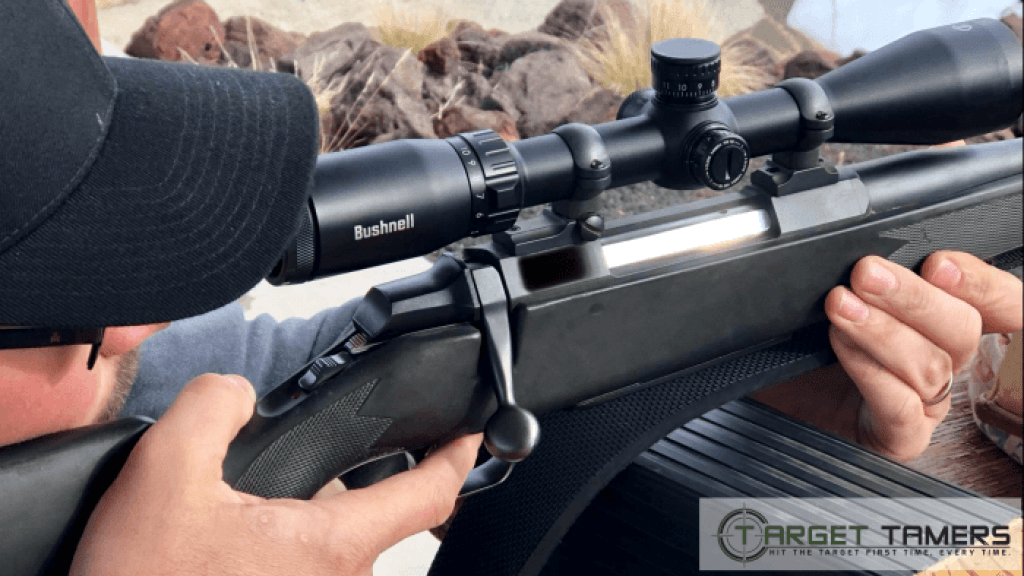
2. Budget
While there are long range, varmint, and even air gun rifle scopes, the majority of hunting scopes cater to the mainstream huntsman.
With such a wide variety of hunting scopes to choose from between brands, your budget might just be the factor that helps in the elimination process.
The good news is, whether your budget is low, medium, high or unlimited, there are plenty of options to choose from.
3. Duplex Reticle
This reticle is going to be the most common type of hunting reticle around, and there's a reason for that.
It's simple, uncluttered, straightforward, and it does what it's designed to do - draw your eye to the center. You won't need much more than this if you're sticking to standard deer hunting distances.
A basic BDC reticle would be okay on a 3-9X or 3-12X. It would be more fitting on a 4-12X rifle scope, but for anything less like a 2-7X, a BDC reticle would be overkill and a waste of money.
4. Eye Relief
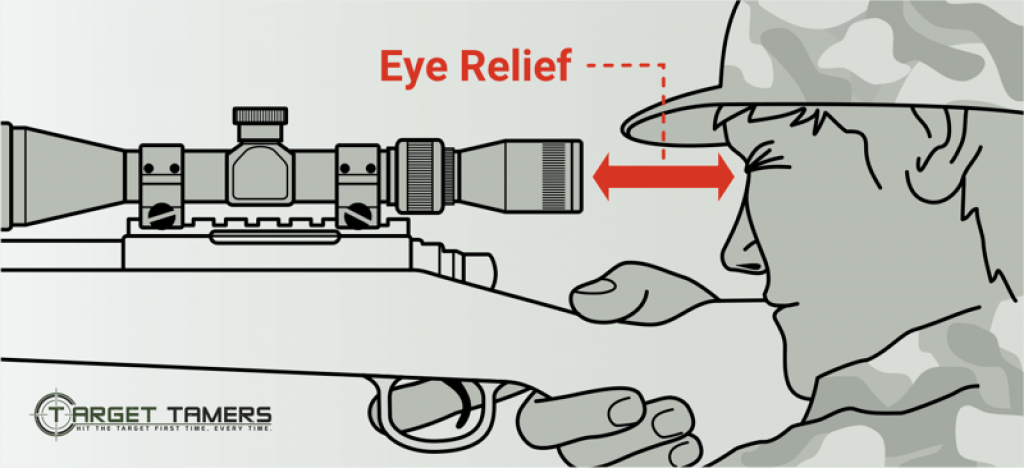
There's so many rifles and calibers that you can use to have an efficient and productive hunt within 300 yards. And, within that large range, there are many rifle scopes that have different levels of recoil.
Make sure that your choice of rifle scope has enough eye relief to provide sufficient clearance between the scope and your face - if you don't, that could be a painful teaching moment!
While 3 inches is considered a good-enough amount of eye relief, I would suggest going a little longer in the 4 inch or even up to 5 inch range.
Not only should you be able to have a clear and consistent field of view and exit pupil, you should also be comfortable to get an identical cheek weld every time.
5. Illumination
A good hunt is most likely going to reach its peak around sunset - low light hours where deer are on the move.
Having an illumination feature will definitely help you see better, stay out longer, and shoot more accurately.
Since illuminated reticles can run up the bill rather quickly, you might want to consider the economical and affordable illuminated models of our Weaver, Barska, and Simmons rifle scope recommendations.
Benefits of Hunting Scopes:
- Large market to purchase from
- Increases accuracy and precision
- Offers most versatile magnification ranges
- Most suitable for almost all types of targets
- Doesn't always require added features
- Cheaper than high powered optics
Disadvantages of Hunting Scopes:
- Higher power hunting scopes may encourage hunters to carry more magnification than they need
- Can get more complicated, costly, and heavier with added features
Check Out Our Pick of the Best Deer Hunting Scopes Here.
Varmint Hunting
Varmint control has been an important part of hunting culture for as long as time.
Keeping crops, cattle, chickens, and property properly protected meant keeping the pests under control and to a minimum.
If you're looking to mount a scope to a varmint rifle, then let's jump right in to some notes on varmint hunting.
Variable Size
Types of varmints can be on the large end like coyotes, feral dogs, foxes, and bobcats.
On the other end of the scale, they can be as small and fast as prairie dogs, jackrabbits, ground squirrels, and all of the like.
Versatility is Key
The name of the game in varmint hunting is versatility. Varmints are fast, stealthy, wily, wary, and intelligent.
You want a versatile optic to be able to keep up with the challenging, but enjoyable, hunting conditions varmint shooting provides.
Varmint shooting in close ranges can be anywhere below 100 yards in wooded, thick brush areas.
But then again, varmint hunting can also take you to the plains of the Wild American West where you'll spot those fast and small targets from 400 yards away.
Common Varmint Hunting Calibers
Varmint rifles aren't just the carry-around, small-caliber, or rimfire rifles that you'd think of when taking care of vermin. But if that is the gear you are using, this article on the best rimfire scopes for .22LR has some great options.
Although, adequate for the job in chambering 3000+ fps bullet velocities, varmint rifles can be as powerful as a .30-30 Winchester lever action rifle.
But, when it comes to caliber, you'll see .22s and even smaller caliber bullets in varmint hunting. Some of the most common caliber cartridges for this hunting category are the:
- .204 Ruger (4000+ fps)
- 6 mm Remington (good for over 220 yards)
- .25-06 Remington (good for over 400 yards)
- 17 Remington (smaller than .22)
- .22 Hornet (low noise)
- .22-250 (good .22 choice for high velocity and longer range)
- .220 Swift (4000+ fps)
- .223 Remington (3000+ fps)
What to Look For in a Varmint Rifle Scope
1. Varmint Reticles
Varmint reticles can be as simple as a dot or an open circle in the center of a duplex reticle or as complicated as a tactical Christmas tree styled reticle.
Depending on the type of terrain you'll be hunting in, you'll need to determine what type of reticle is for you.
Some Varmint Hunter reticles incorporate bullet drop compensation data on the lens.
2. Magnification
Now, if you're going to be doing some serious close range varmint hunting in wooded areas, then magnification isn't going to be vital. You will want to look in the 1-4X or fixed 3X magnification range.
But, since varmints aren't always conveniently facing you broadside at a close enough distance, your scope should have a decent amount of magnification to it.
If you're taking out small targets at 200 plus distances, you'd want to go with a 3-12X, 4-12X, or 4-16X rifle scope. You'll have the ability to come in close or range out far to see every spec of dust on that tan coat of hair that ground hog has.
Some varmint rifle scopes may even require more magnification than that - there you'll truly learn how to shoot between breathing and heart beats... not a bad way to become a skilled and accurate hunter.
3. SFP vs FFP Reticles
Just as important as high power for those long range varmint shots is fine cross hairs.
There's quite some debate as to whether or not a FFP or SFP reticle is more appropriate for varmint hunting.
While larger varmints with kill zones of 4 inches and more might do just fine with a FFP reticle, you might want to stick with a SFP reticle for small varmints like prairie dogs. Prairie dogs know you're coming from a long way away. At 100 yards, they're going to annoyingly duck back into their little holes.
If you're going for a shot that's well beyond that 100 yards, you're going to need high magnification, maybe a BDC reticle, and a fine cross hair - illumination is optional.
With a FFP reticle, you can use the BDC at any magnification, but at ranges like this, you're more than likely going to keep your power at the highest setting. This means that with a SFP reticle, the cross hairs will remain nice and thin so that you can see every part of the vital zone on the prairie dog.
Just remember that even the slightest miscalculation of bullet drop on a prairie dog could mean a miss.
So weigh up whether you want to pay more for FFP or if you'll stick to max magnification at all times to get that long distance shot on a small, moving target. You could always just get a laser rangefinder too.
4. Weight
Most rifle scopes are compact and light weight in the 10-16 ounce range whereas heavier rifle scopes weigh in on the 20 plus ounce range.
Although a light weight, carry-around rifle may sport a varmint scope that's great for stalking prey around your property perimeters, you might want to consider the heifer scopes for a different but good reason...
When varmint shooting at long distances, you may need to set up. The heavier weight of the scope may be a non-issue since heavy barrel rifles are used for fixed position hunting which also increases accuracy versus a light barrel.
If you don't mind a whopper of a scope because you have a whopper of a rifle, then you pretty much have given yourself license to load up your optic with weight-adding features that can help make your varmint hunting more productive.
Illumination control, parallax adjustment, large objective bell, here we come.
5. Parallax Adjustment
For ranging out long distances, you can't go without it, unless you're a master at the cheek weld method.
In fact, even if you are a cheek weld master, since neck fatigue, sweat, high mounted rings, and hurried eye-to-the-scope shots can affect accuracy, you might want an option to reduce as much cross hair travel as possible, especially on your small targets.
6. Illumination
As mentioned above, illumination isn't required, but it sure can be handy for those long distance shots where fine SFP cross hairs can get lost on the image.
An illuminated reticle could save the day for you or the lack of one may spare the target another day.
7. Objective Diameter
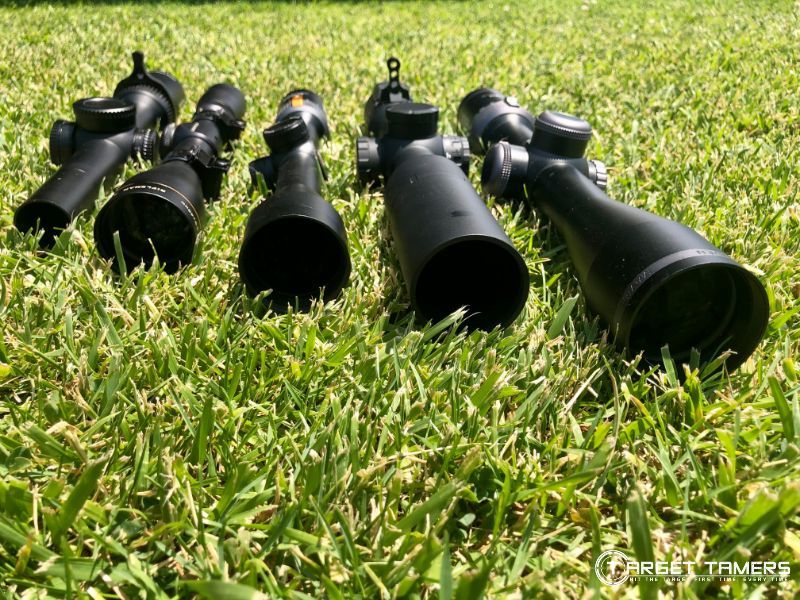
It wouldn't be much fun if varmints slept all night and hunted all day - it would make the hunt too easy.
A larger objective bell could mean an increased exit pupil and field of view - two things that are needed to get a great image in low light conditions on moving varmints.
Generally, the larger objective lens you have, the possibility you could stay out longer to catch who's responsible for terrorizing your livestock at night.
If you're not entirely sure about objective lens size, check out this informative article to help you make the best rifle scope purchase for your firearm.
Benefits of Varmint Scopes:
- Specifically designed for varmint hunting
- Is effective for close range and long range hunting
- Reticles are suited for varmints
- Extra perks and features are justifiable
- Rifle scope weight may be a non-issue
- Often mounted to firearms with little to no recoil
- With the right specs, suitable for all-round hunting
Disadvantages of Varmint Scopes:
- Can get more complicated, costly, and heavier with added features
- Extra features may encourage inaccurate shots under poor conditions
- May cost you extra to purchase a bipod for fixed position hunting
- May cost you extra to purchase a sling if you choose to walk and stalk
Check Out Our Pick of the Best Varmint Hunting Scopes Here.
AR Hunting
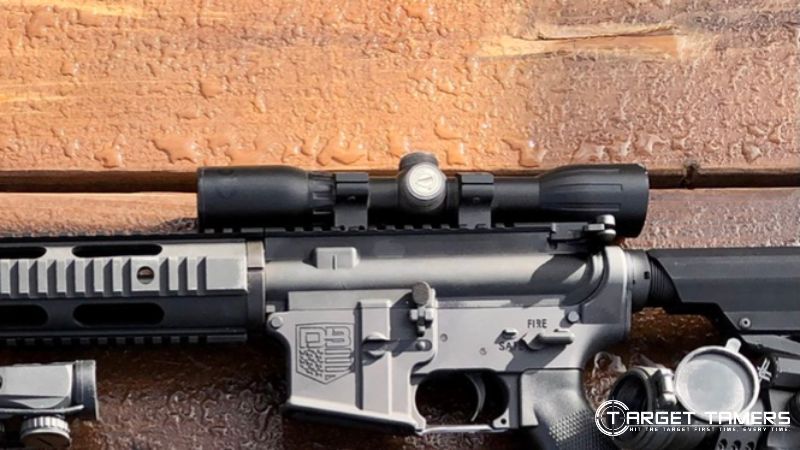
When looking for a good AR rifle scope for an AR 15 or AR 10, you'll probably find yourself in the tactical scope category. Nothing wrong with that, it's just the norm. But, it's actually quite common to mount a hunting rifle scope to an AR to hunt with.
Let's go over some notes on how you can improve your hunt with an AR.
A Controversial Topic
Using an AR to hunt is a controversial topic, to say the least.
We're covering the use of an AR for hunting because when used in the right hands with skill, ethics, and the right equipment (optics, caliber, distance, conditions etc), there's no reason to disregard the AR as a good tool for the job.
Best-Kept Secret
There are more ARs than there are rifle scopes for this iconic American rifle, and that's because of its modularity.
It's versatile design platform can make the AR a beastly component when hunting, which is why it's the best-kept secret of the AR hunting club.
Popular ARs
One of the most popular ARs to date is Remington's R-15, which is arguably the first hunting AR-15 style rifle that was made and based off the military's M16.
Remington also made the R-25 based off the AR 10.
Calibers
There are many different calibers for an AR, ranging from a .17 Remington and .22LR to a .50 Beowulf and even a .300 Win Magnum.
By far the most common caliber is the .223 Remington that is the the most common rifle cartridge used for varmint rifles.
Although the 5.56mm is similar to the .223, they're not identical. While you can use a .223 in the military 5.56mm chamber, you shouldn't load a 5.56mm in a .223 unless you have a death wish.
If your local area restricts the use of a .223 for hunting, here are some alternative calibers that you can use. The 6.5 Grendel, 6.8 Remington SPC, .300 AAC Blackout, .450 Bushmaster, .458 SOCOM, and the .50 Beowulf.
Big Game Hunting
An AR 10 style rifle is an excellent big-game predator hunting tool if you use the right size caliber. You can use .308, .243, .260 Remington, 7mm-08, and most of those similar-sized loads.
Shot Placement is Key
It's all about shot placement. Don't use an AR for hunting if you cannot ethically take down the right target at the right time with the right bullet to minimize as much unnecessary pain and suffering as possible.
You want one-shot kills.
If it means using a .22 for a rabbit, arguably a .223 for a hog, 25-06 for deer, and 45-70 on a bear, you need to know your stuff. Just like with using any firearm for hunting - practice, skill, and knowledge of vital/kill zones are of import.
AR users are bound to the same rules as all other rifle hunters.
Various Optics Available
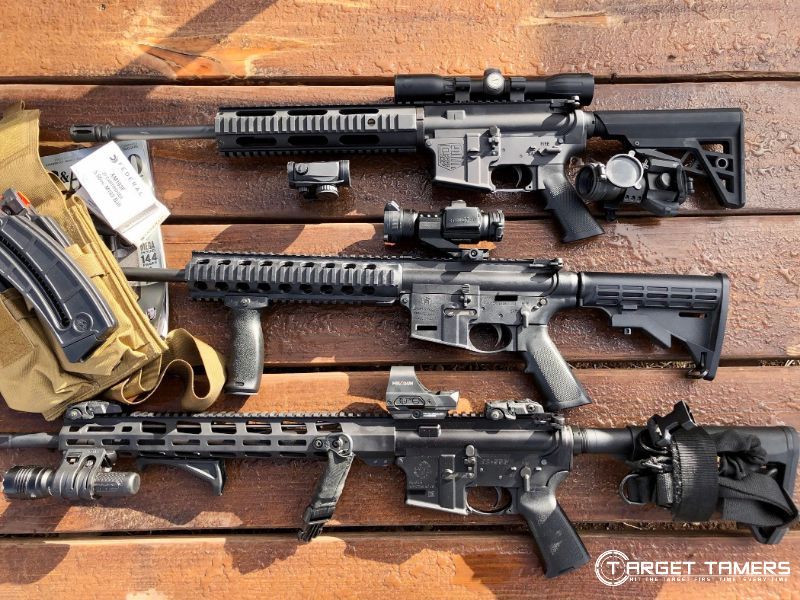
There are many types of optics suitable for an AR, ranging from rifle scopes, red dots, and holographic scopes.
The hunting optic that we will discuss in the next section will be the rifle scope for its use on an AR 10 or AR 15 for hunting.
What to Look For in an AR Rifle Scope
1. Quality Glass
All one shot kills are thanks to great optics, and great optics are made with quality glass.
Make sure you have quality fully multi-coated lens and pristine, crystal clear glass to be able to see every detail of your kill zone when making your one-shot, kill-shot with an AR.
2. Magnification
This really comes down to what you're going to be hunting with your AR.
To choose the right magnification range, you'll want to think about what your average distances will be, the type of target, and what loads are appropriate for that shot.
If you're not sure or if you're wanting a versatile optic that can range in on 100 yards for hogs or a 400 yard long distance shot may present itself, you might want to consider a variable scope in the 3-12X or 4-16X range. You can always set it to one power and leave it there if you prefer.
The important thing about hunting with an AR is to be target-specific. If you're using a .22LR round, don't go taking shots at deer 250 yards away.
Load the right caliber for the target.
Being caliber and target specific might help you make a wise decision as to what the appropriate magnification levels are for you, especially if you end up needing to make a follow-up shot - tsk tsk.
3. Eye Relief
This isn't going to be a biggie because one of the nicest things about the AR platform is the big coiled spring that keeps recoil to a minimum if there's any at all.
If it's got at least 3 inches of eye relief, you should be good to go.
Uncover the best-rated scope covers to shield against dust, moisture, and scratches, ensuring optimal protection for your optics. Delve into our reviews to pinpoint the ideal match for your needs.
4. Ballistic Turret
If you're not necessarily taking down any live targets at extreme long distances, but you are wanting to test your marksmanship on steel out to 800 yards plus if your rifle is capable of that, then a ballistic turret is exactly what you'll need.
Look for an AR rifle scope that has the ballistic turret with an integrated windage reticle. You also might want to check out other non-AR-specific rifle scopes that have the ballistic turret, parallax adjustment, and high magnification.
5. BDC Reticles
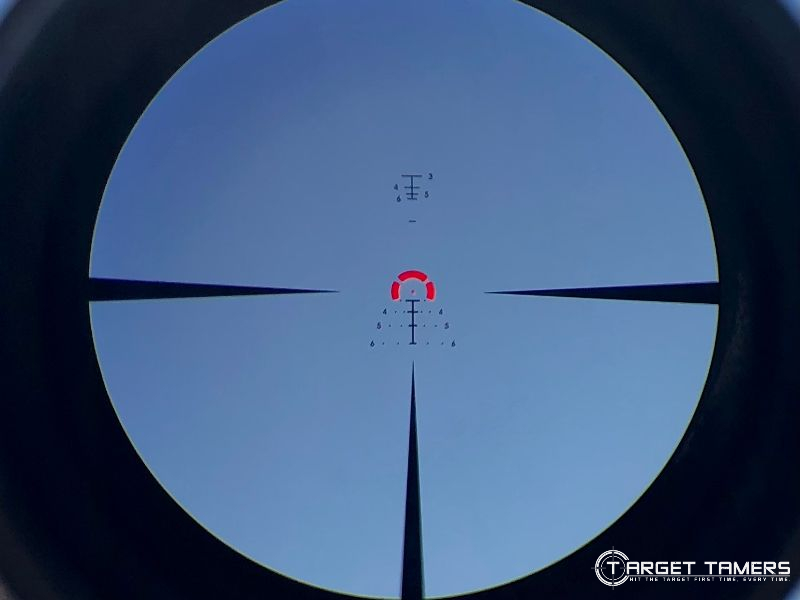
If you prefer a BDC reticle over a ballistic turret, then look specifically for manufacturers that design reticles suited for common calibers of the AR.
Bushnell has a .22LR Rimfire BDC reticle and a .223 reticle. Burris has the C4 reticle, and Leupold has the CMR-W 5.56 and many, many more.
Benefits of AR Scopes
- Designed with reticles specifically for the AR
- Can have added features
- Can be as versatile as you want it to be
- Don't need long eye relief
- For an AR, you're not restricted to only considering AR scopes, you can shop the conventional rifle scope market
Disadvantages of AR Scopes
- Specific AR category of rifle scopes is a smaller market than conventional rifle scopes
- Variety of AR optics available can be overwhelming
Check Out Our Pick of the Best AR Scopes Here.
Air Gun Shooting & Hunting
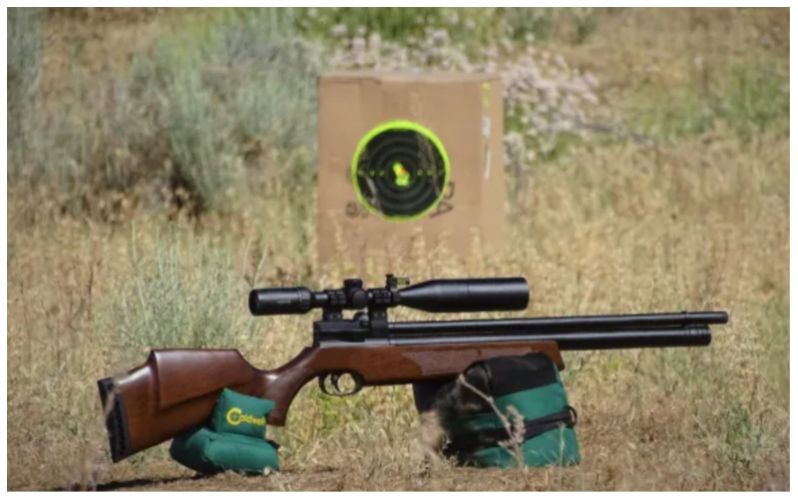
If you're target shooting, small game hunting, keeping pests under control, competition shooting, and even varmint hunting, an air rifle can do all those jobs with the right caliber and energy.
Before we delve into what to look for when shopping for a rifle scope for an air gun, lets cover a few notes on air gun shooting & hunting.

Types of Air Guns
There are quite the array of types of air guns available today:
- PCP (Pre-charged Pneumatic)
- Spring powered
- Gas piston
- CO2
- Variable pumps
What is the most popular type of air rifle?
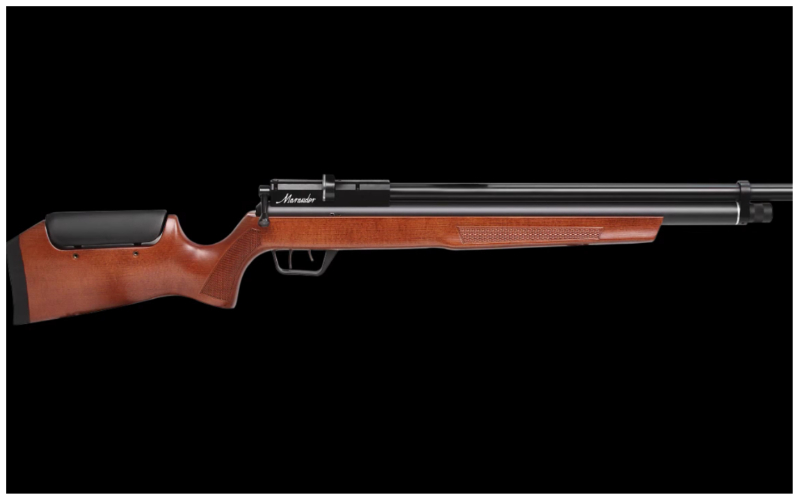
That would be the high-powered PCP.
Pros:
- Powerful (higher compressed air pressure)
- Minimal recoil
- Low noise level (shrouds)
- Repeater models (multi-shot with magazines)
- Versatile & adaptable (.177 - .50 cal)
- Lightweight
- Some self-contained models (with drawbacks)
Cons:
- More expensive to purchase
- More expensive to maintain (repairs, equipment, etc.)
Calibers for Hunting
Ammunition for air guns are called pellets. There are pointed, domed, hollow points, high velocity, and Wadcutter pellets.
For hunting with an air gun, the most common calibers are the .177, .20, .22, and .25 calibers.
Check the Laws
If you're varmint and predator hunting with an air gun, you'll first need to check local and state regulations to ensure you can safely do so within the law.
For varmint hunting pests like possums, raccoons, prairie dogs, and woodchucks, you'll want to make sure you are equipped with the right type of air gun and caliber over .22.
Since PCPs can be very effective with larger calibers up to .50 cal, you can hunt anything from coyotes to boars and more!
What to Look For in an Air Gun Rifle Scope
1. Magnification
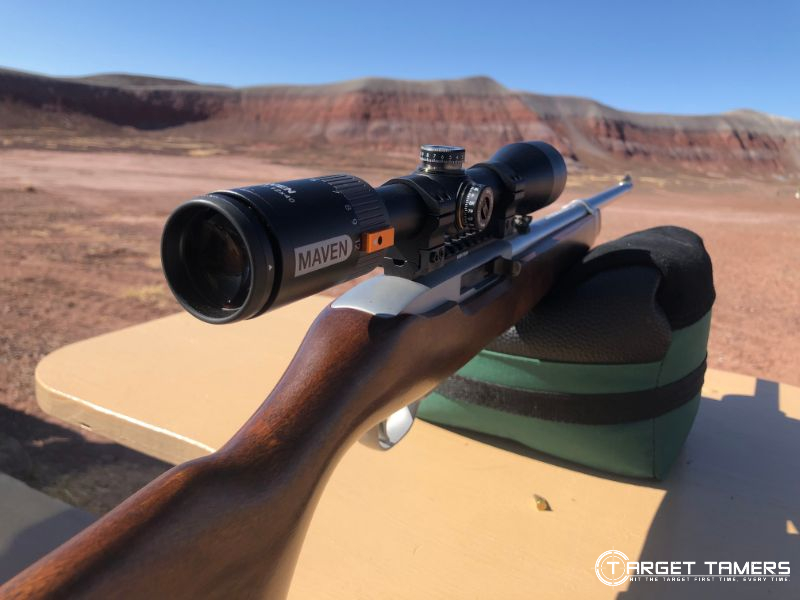
Really any range within the 1-16X range is going to be suitable for air gunners.
But, for most air gun applications, a scope with 1-4X or 2-7X is rather appropriate since you typically won't be shooting near 100 yards.
On the other hand, if you're considering doing some serious varmint and predator hunting, 3-12X and 4-16X is an all-round power range to consider.
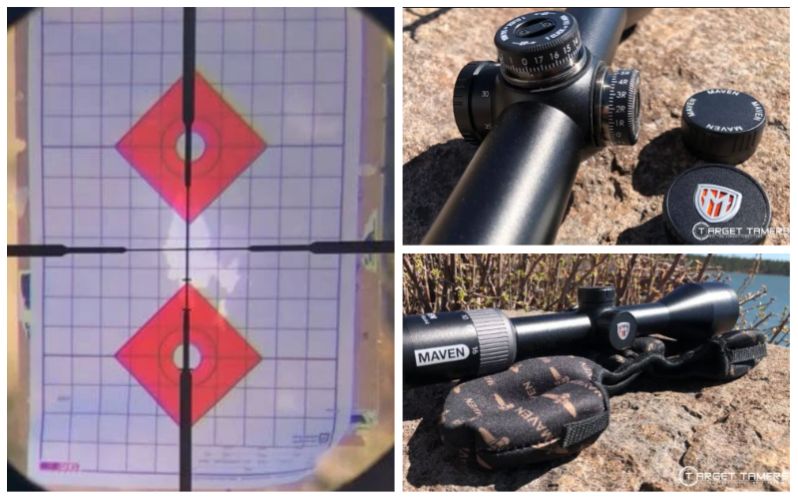
For example, for the PCP, the Maven CRS hunting scopes offer multi-purpose power ranges. The field-tested CRS.2 has 4-16x magnification with Japanese glass, a parallax side focus, and a simple BDC-style CSHR reticle in the SFP.
2. Recoil-proofing
If you're a hunter, it might be tempting to put a conventional hunting rifle scope on top of an air gun.
That could be a costly mistake.
Air guns have forward and reverse recoil because of its unique construction and may throw the reticle out of alignment if you put it on a spring air gun.
Because of this, choose an air gun scope that has a recoil rating to match that of your air gun.
Can you put any scope on a PCP?
PCP and CO2 air guns have recoil but so little compared to the spring power that it's not unreasonable to say that they don't have felt recoil. Though you can put any scope on a PCP or CO2, scope features to consider include focus (parallax correction), weight, and perhaps illumination.
3. Parallax Correction
While many hunters may recognize this feature for being able to focus the image and eliminate parallax for those long distance shots, air gunners also benefit from the AO (adjustable objective) or SF (side focus).
While most air rifles are factory-set to be parallax free at anywhere between 50 to 100 yards, an AO will give the user flexibility to achieve maximum accuracy in short or close range distances.
The primary feature to look for in a SF or AO is the minimum focusing distance which should be 10 or 15 yards for air gunners.
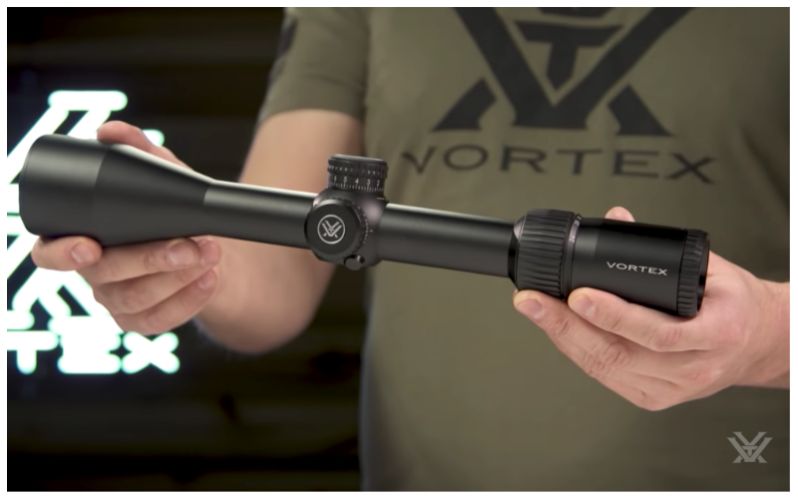
A fantastic scope to consider for low-recoil air rifles is the Vortex Diamondback Tactical 6-24x50. It's an FFP scope made to go the distance with a SF that focuses down to 10 yards. The best feature? It's one of the best FFP scopes under $500.
4. Weight
Look for a lightweight and compact air rifle scope.
Since these types of air gun rifles are often carry-around guns, you will need to consider overall bulk and weight of the scope.
Will it handle an all day trek in the bush? Is it only going to be used for those "darn, those critters are back" moments? Or, will you be competition shooting standing or sitting?
Evaluate your shooting conditions and how you'll be using the air gun - the application. This will help to determine whether every ounce and inch is important or if it's a non-issue.
5. BDC Reticles
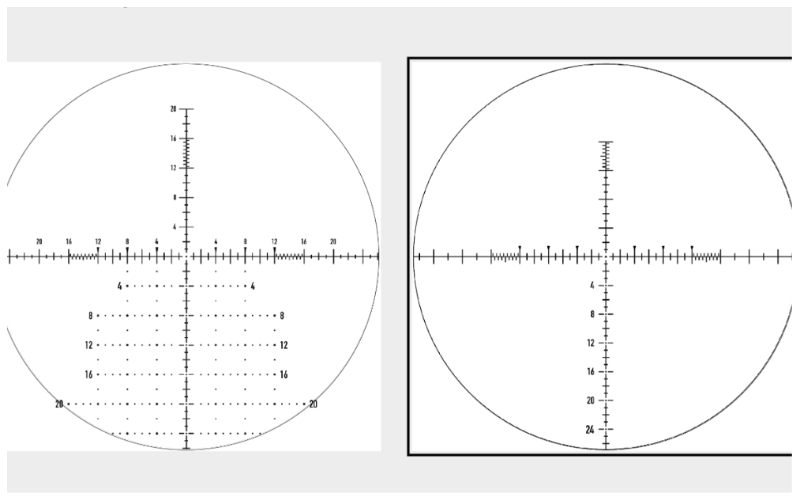
Though many are shooting inside 100 yards with air rifles, it doesn't mean that others aren't taking it to 150 yards and more. Pellets are susceptible to wind, and of course, they experience drop. For those looking for more than a standard plex reticle, a BDC reticle may be useful.
Now, BDC reticles vary in design from simple marks to Christmas-tree style reticles. You must consider the distances you'll be shooting and the application.
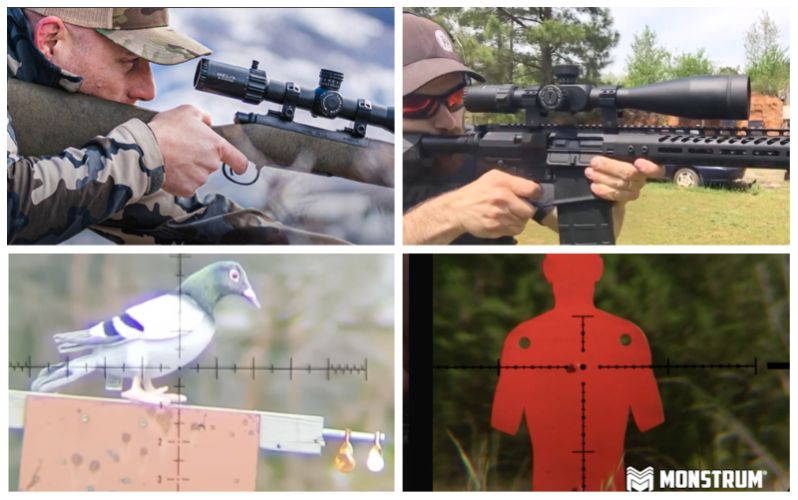
For a higher priced scope, the Elements Helix 4-16x44 has the APR-1C reticle in the FFP available in MOA or MRAD. For a cost-friendlier version, the Monstrum G3 6-24x50 has the Custom Type-H illuminated reticle in the FFP.
Benefits of Air Gun Scopes
- Scopes are designed for forward and reverse recoil from spring/break action air guns
- You can match recoil ratings on scopes with ratings on air guns
- Scopes are versatile to use for target shooting, varmint and predator hunting, and recreational shooting
- Often less expensive than conventional rifle scopes
Disadvantages of Air Gun Scopes
- Scope for centerfire air gun rifle may be parallax free at 100 yards causing parallax issues for closer ranges
- SF or AO feature will cost more than scope without it
- High power air gun scopes may encourage air gunners to take longer shots than the pellet is capable of. (Increased power doesn't improve flat pellet trajectory or pellet velocity)
The Bottom Line?
Choose appropriately.
You don't need a long range hunting scope that's outfitted for a 30-06 or .308 or on a .17 caliber rifle. Likewise, a full-on tactical scope is overkill if you're plinking in the backyard.
You should also know that you shouldn't use a scope designed for a conventional hunting rifle on an air gun. Just give it a try, that one-time use you get out of it or costly buy with perks you'll never use will be your lesson well learned.
Be it on the range, the open fields, brush country, the rocky mountains, for your bug-out bag or a tactical scenario, rifle scopes will change the way you shoot.
It doesn't matter if you're sporting a 444 Marlin, 25-06 Remington, or a .22 Hornet, there's a rifle scope that's ideal for you.
If there's any good advice to take away with you today, it's know what you're hunting for - in the field and in the optics market.
Ready to go Scope Shopping? Check out the TOP RIFLE SCOPE Options here.
Further Reading





It would be great to see the airgun section updated for modern high-powered PCPs as it seems the suggestions are not useful for them. It's an air rifle, but you're easily shooting 50-150m with pin-point accuracy and therefore basic scopes aren't going to cope with the adjustments required for pellet drop and general distance.
I think it's a great educational post all the same.
Thanks for your feedback Cam! We have updated the article with some information about and scope recommendations for PCP's.